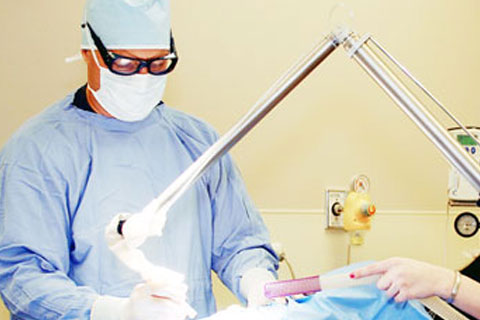Minimally invasive surgery accomplishes the goals of traditional surgery by the use of sophisticated equipment designed to work through very small ports. The advantage is greater comfort for the patient, outstanding hemostasis (control of bleeding) and view of the surgical field. Minimally invasive surgery in the abdominal cavity using a rigid video scope is called laparoscopy.
I first learned about laparoscopy four years ago while attending a meeting in Orlando, Florida that was specifically focused on liver diseases. A portion of the course was an introduction to laparoscopic surgery for the purpose of obtaining liver biopsies. I was impressed by the incredible optics, visualization of the liver as well as the techniques for obtaining fabulous biopsy samples leading to accurate diagnoses. I often say what can be seen laparoscopically is as beautiful as a sunset.
Since the time of the meeting I have brought laparoscopic technology into West Suburban Vet. In addition, we have had specialists come into the hospital for the purpose of training the staff on laparoscopic procedures. We have been performing liver biopsies and with the additional training and experience we are performing other procedures including spays (ovariectomy). In fact, most female dogs and cats from the humane society are now spayed laparoscopically. Lets look at how this works and the benefits of the procedure.
Anesthesia considerations as well as pain medications are the same as a traditional spay. Two very small openings approximately 1/3 of an inch each are made one above and one below the umbilicus (navel) both openings on the midline. Carbon dioxide gas is flowed into the abdomen to distend the cavity. One opening is used for a rigid scope that has a camera attached that transmits a picture to a monitor in the operating room. The monitor becomes the eyes of the surgeon. The other opening is used to pass surgical instruments into the abdominal cavity; that are then watched by the camera system. Using specialized laparoscopic equipment the spay is performed. Overall there is far less handling of the tissue and the surgical maneuvers are very precise.
The end result is a surgical procedure that is much less traumatic to the patient. There is less bleeding, less pain, and far better visualization of the surgical field with this procedure. In fact with the distention of the abdomen, the eye of the scope being with in the abdominal cavity, and with the outstanding xenon lighting on the scope, the view far exceeds traditional surgical approaches. In addition the closure is very small and often tissue glue is used on the skin so that no suture removal is needed.
Liver biopsies and spays are not the only procedures that can be performed laparoscopically. In addition gastropexies to prevent dogs from bloating, other organ biopsies, and abdominal exploratory can be performed. Also the equipment can be used for urinary bladder procedures (cystoscopy) as well as rhinoscopy and bronchoscopy. As with all these procedures they are minimally invasive, offer very precise tissue handling through outstanding visualization of the surgical field.
These procedures are a big step forward in quality of care and comfort for animals. It is very exciting that this level of care is available and currently being utilized on many West Suburban Humane Society pets




 WSHS can accept credit-card donations online using a secure server. Click on the Donate Now button. You can choose how your donation will be used! All donations are tax deductible.
WSHS can accept credit-card donations online using a secure server. Click on the Donate Now button. You can choose how your donation will be used! All donations are tax deductible.